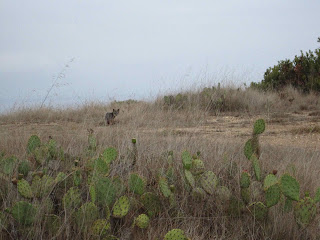Who Hiked: Me
Route: Big Springs Loop
Time: 1000 to 1300
Estimated Distance: 5 miles
Weather: cool and overcast
This is a fun hike that is not too challenging and offers a lot of things to see: beautiful views, water habitats, island vegetation, and a cat-tail filled spring. While it is not easy to get to -- you can walk up from Two Harbors or Little Harbor, or drive from either, it is worth the effort.
I have not been hiking much lately, but for good reasons. First, since September 1st, I have been working for the Wrigley Institute for Environmental Studies (at the Wrigley Marine Science Center in Big Fisherman Cove). Second, I have had some success in my freelance writing efforts and have been spending time writing up pieces that I have under contract.
But on an overcast and dreary Monday in September, I did get out of the house to hike the Big Springs Loop, which I previously hiked in November 2009.
My drive to the starting point started auspiciously enough: I saw an American avocet flying over a small reservoir at the buffalo gate at Deer Valley, just above Two Harbors. Also spotted near the gate was a female American kestrel, perched in a tree with her back to me.
 |
| The fox finally noticed me. |
I continued up the hill to the crest, where the road makes a sharp turn to the right. The view from this part of the trail is wonderful -- you can see Empire Landing below you and, on clear days, you have great views of the mainland. There are sections along this stretch where the bushes (mainly lemonadeberry and toyon) and trees (oaks) come close to the road making it feel cozy and protected. I like that feeling of being surrounded by vegetation, so I really enjoyed this part of the hike. There are also interesting rock formations along the way. Lots of Spotted towhees, Northern mockingbirds, unidentified hummingbirds here.
 |
| Big Springs Reservoir in 2011 |
By 1100 I reached the junction of Big Springs Road and another road that takes one to the airport. Big Springs Road is downhill until it flattens out at the Big Springs Reservoir. Twenty minutes later I reached the Reservoir, which still has water in it, even this late in the dry season. The last time I hiked here, the Reservoir was dry as a bone!
I spent a fair bit of time at the water, watching birds, dragonflies, and damselflies. The odonates were abundant -- I saw at least five species who were courting and mating. My best guesses (using my "Dragonflies through binoculars" book) are below. I also watched as a mayfly rose from the surface of the water into the air, only to be pounced on by a dragonfly.
The toyon was setting fruit, which was still mostly green but starting to ripen. Lemonadeberry bushes have fruits as well, but not very big yet.
I left the Reservoir and continues along the road to the turn where Big Springs Road heads uphill, back toward the junction with the main road. There is a spring-fed creek along the Road here, where cat tails thrive.
At the main road, I headed up a steep secondary road that travels along the back side of a hill and comes down behind the bison corrals along Little Harbor Road. The Acorn woodpeckers like the telephone poles and I saw one very noisy individual hammering away at the wood.
At the small reservoir next to the bison corral, I saw more damselflies and dragonflies (same species as before), a House wren, a mallard or black duck female sitting on her nest, and a yellowlegs flying in for a landing in the water. (I'm pretty sure it was a Greater yellowlegs.)
I walked along a deer path that ran parallel to the main road and reached the truck by 1300. I headed home, happy for the chance to hike and looking forward to my next opportunity.
Birds seen/heard: American avocet, American kestrel, Western meadowlark, Spotted towhee, Black duck or mallard (female), Northern mockingbirds, House finches, Northern ravens, Say's phoebe, Great blue heron, Killdeer, Mourning dove, Spotted sandpiper, Brown-headed cowbirds, Horned larks, Acorn woodpecker, House wren, Greater yellowlegs (probably)
Odonates:
Species 1: at least 3" long, males had blue abdomen with green thorax, females were all green, saw mating pairs and singletons, mating females were ovipositing by sitting and probing aquatic vegetation with tip of abdomen (Family Aeshniidae, Anax junius, common green darner)
 |
| Exoskeleton from a recently metamorphosed dragonfly |
Species 3: about 1.5" long, rusty red body with clear and colorless wings, no mating pairs (Family Libellulidae, probably Paltothemis lineatipes, Red rock skimmer)
Species 5: damselfly from the Family Coenagrionidae -- bright blue body, smoky wings, about 1.5" long and slender.
No comments:
Post a Comment
Note: Only a member of this blog may post a comment.